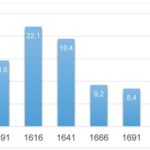The evolution of unmarried women in England is explained by the trades they performed. In the English case, the spinner’s trade was associated with female spinsterhood, which reached its peak during the 17th century. Thus, in a context where the formation of marriage was seen as the goal of any woman, the work of the spinner, associated with spinsterhood, began to have negative considerations, thus creating a stereotype of the woman who carried out this activity.
Collection: Graphics
Project: 4. Family, daily life and social inequality in Europe., 8. Women and the change for gender equality in Europe.
Chronology: XVI, XVII, XVIII
Scope: Secondary Education, Baccalaureate, University
Link: https://e-revistas.uc3m.es/index.php/REVHISTO/article/view/3702/2308
Resource type: Graph
Format: Bar chart
Source: Simón Hernández, F. (2017). “El estereotipo de la solterona: literatura y construcción social en la Inglaterra de Jane Austen (1775-1817)”, en Revista de historiografía, nº 26, p. 133.
Language: Spanish
Date: 2017
Owner: Pablo Ballesta Fernández (Modernalia)
Copyright: © Instituto de Historiografía "Julio Caro Baroja" de la Universidad Carlos III © Fátima Simón Hernández
Abstract: Single women in England according to the stereotypes of the spinning wheel
Image
Tags








